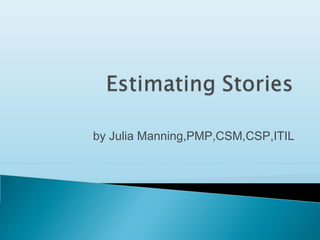
Estimating Stories
- 2. I –Independent N-Negotiable V-Valuable E-Estimable S-Small T-Testable by Julia Manning,PMP,CSM,CSP,ITIL
- 3. Not ◦ Estimating Cost ◦ Estimating Time Must Have ◦ Shared Team Understanding In agile approach, we don’t estimate how much money we spend on developing each user story. Instead developing estimates project or release planning meant to create share understanding of the relative size and complexity of each story. by Julia Manning,PMP,CSM,CSP,ITIL
- 4. Step 1 Choose a reference Point Step 2 Discuss the Story Step 3 Decide on estimate individually Step 4 Check for Consensus Step 5 Repeat the process Step 6 Reach for Consensus Note: First step reference point story ideally including all members of the project team should chose a reference point story. Usually this should be averaged size story that allows the team to characterize the remaining stories as either smaller or larger. by Julia Manning,PMP,CSM,CSP,ITIL
- 5. Story Points complexity in relation to other stories have more size is an indicator of complexity. However a simple story may involve the same amount of work. Estimating Definition: The relative size of each user story in terms of the work effort required to develop it. Shirt Size-S,M,L,XL Fibonacci- 1,2,3,4,13,21 Ideal Days- 10 days- Actual Elapsed the 15 Days Fibonacci Definition
- 6. If take more than 5 days of effort You can split the stories the following ways: Data Boundaries Operation Boundaries- e.g. CRUD Cross-Functional Features – e.g. “Admin Privileges” Non-Functional performance requirements Sub-Stories of Mixed Priority by Julia Manning,PMP,CSM,CSP,ITIL
- 7. After the first story is sized it can be used as a reference point for estimating the sizes of other user stories. Any user story that requires more work to develop than the reference user story should be assigned a higher point value and smaller stories should be assigned proportionally lower values. Dedicated Planning Poker Meeting During Each Sprint. Can make fun by using planning poker games! https://www.planningpoker.com/ by Julia Manning,PMP,CSM,CSP,ITIL
